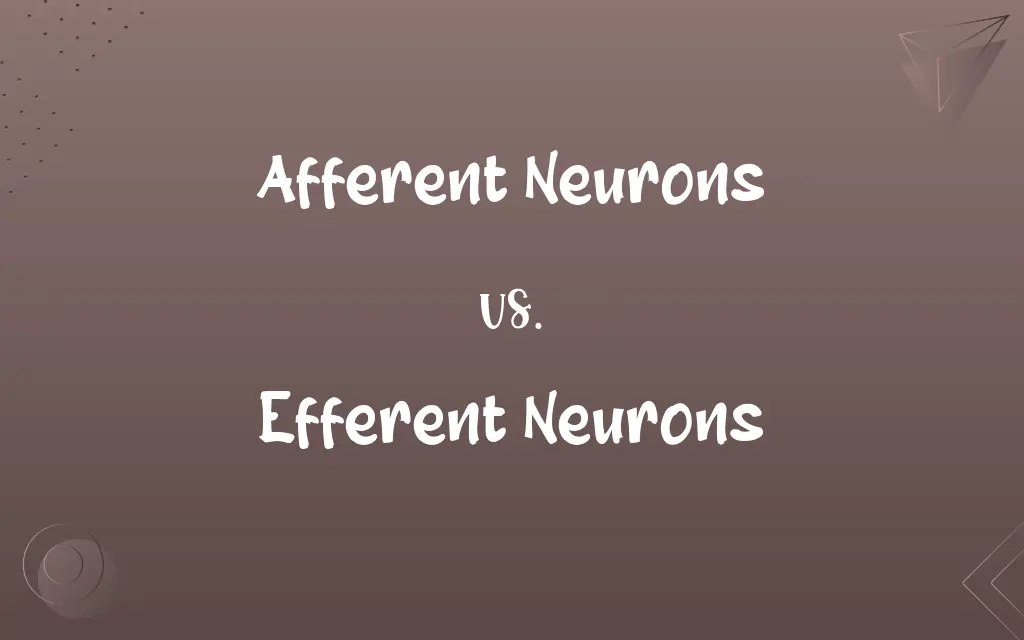Afferent Neurons vs. Efferent Neurons: Know the Difference
Afferent neurons transmit sensory signals to the central nervous system, while efferent neurons carry motor signals from the central nervous system to muscles and glands.

Key Differences
Afferent neurons, also known as sensory neurons, are responsible for conveying sensory information from the body to the central nervous system (CNS), allowing the brain to perceive external and internal stimuli. In contrast, efferent neurons, or motor neurons, transmit signals from the CNS to effectors like muscles and glands, enabling responses and actions.
The role of afferent neurons is to detect changes in the environment, such as temperature or pressure, and relay this information to the brain and spinal cord. Efferent neurons, on the other hand, play a crucial role in executing motor functions by sending instructions from the brain to the body's muscles and glands.
Afferent neurons are part of the body's input system, collecting sensory data which is then processed by the CNS. Efferent neurons function as the body's output system, delivering processed information and commands from the CNS to the peripheral body parts.
The structure of afferent neurons is specialized for receiving various types of sensory input, such as touch, heat, or pain. Efferent neurons have a structure adapted to effectively transmit motor neural signals to specific body parts for action.
In summary, afferent neurons are vital for sensing the environment and internal body states, while efferent neurons are essential for responding to these sensory inputs by initiating actions or physiological responses.
ADVERTISEMENT
Comparison Chart
Function
Transmit sensory information to CNS
Carry motor commands from CNS to muscles/glands
Direction of Signal
From sensory receptors to CNS
From CNS to peripheral effectors
Type of Information Carried
Sensory data (e.g., touch, temperature)
Motor instructions (e.g., muscle movement)
Role in Nervous System
Part of the sensory (input) pathway
Part of the motor (output) pathway
Connection
Connects external/internal stimuli to CNS
Connects CNS to muscles and glands
ADVERTISEMENT
Afferent Neurons and Efferent Neurons Definitions
Afferent Neurons
Neurons that relay sensory data to the brain and spinal cord.
Afferent neurons carry information about food flavors to the brain.
Efferent Neurons
Pathways for executing actions via signals to muscles and glands.
Blinking is controlled by efferent neurons.
Afferent Neurons
Sensory neurons transmitting information from body to brain.
Afferent neurons alert the brain when the skin is touched.
Efferent Neurons
Neurons carrying out motor commands to peripheral effectors.
Efferent neurons are active when speaking, controlling vocal cords.
Afferent Neurons
Neurons involved in transmitting external stimuli to the CNS.
Afferent neurons are responsible for the sensation of a gentle breeze.
ADVERTISEMENT
Efferent Neurons
Neurons that transmit motor signals from the CNS to muscles.
Efferent neurons cause muscle contraction for lifting an object.
Afferent Neurons
Pathways for sensory input from the body to the central nervous system.
The feeling of muscle stretch is transmitted by afferent neurons.
Efferent Neurons
Motor neurons sending instructions from the brain to the body.
Efferent neurons are involved in the reflex action of pulling a hand away from a sharp object.
Afferent Neurons
Neurons that carry sensory signals to the central nervous system.
Afferent neurons convey the sensation of a hot object to the brain.
Efferent Neurons
Neurons responsible for transmitting responses from the CNS.
Efferent neurons signal the heart to increase its beating rate.
Repeatedly Asked Queries
What are afferent neurons?
Afferent neurons are sensory neurons that carry signals towards the central nervous system.
What are efferent neurons?
Efferent neurons are motor neurons that carry signals away from the central nervous system to effectors.
Are efferent neurons involved in muscle movement?
Yes, they stimulate muscle contraction and movement.
Do afferent neurons transmit pain?
Yes, they can transmit pain and other sensory information.
Can damage to afferent neurons cause sensory loss?
Yes, it can lead to loss of sensation in affected areas.
Do efferent neurons control glandular responses?
Yes, they can control glands, stimulating secretions.
Do afferent neurons process information?
They transmit information to the CNS where it's processed.
Where are afferent neurons primarily located?
They are located throughout the body, sending signals to the brain and spinal cord.
Are afferent neurons myelinated?
Some are myelinated for faster signal transmission, while others are unmyelinated.
Are efferent neurons involved in digestion?
Yes, they control muscles and glands in the digestive system.
Can afferent neurons be part of reflex arcs?
Yes, they are key components in reflex arcs, transmitting sensory input.
Can efferent neurons influence heart rate?
Yes, they can affect heart rate by controlling cardiac muscles.
Do efferent neurons play a role in reflex actions?
Yes, they act in reflex arcs to produce a response.
Are efferent neurons part of the autonomic nervous system?
Yes, they form part of both the sympathetic and parasympathetic systems.
Do efferent neurons only communicate with muscles?
No, they also communicate with glands and other organs.
Are afferent neurons faster than efferent neurons?
It depends on their myelination; myelinated neurons transmit signals faster.
How do afferent neurons differ in structure from efferent neurons?
Afferent neurons have long dendrites and short axons, while efferent neurons have long axons and short dendrites.
Can efferent neurons be stimulated by drugs?
Yes, certain drugs can stimulate or inhibit efferent neuron activity.
Share this page
Link for your blog / website
HTML
Link to share via messenger









































































